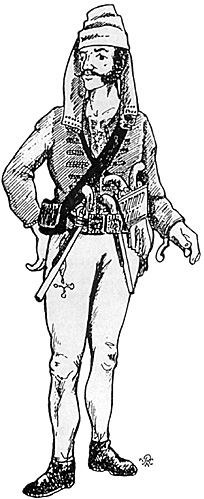 In the index to prints kept in the National Army Museum there
is a reference to an Austrian soldier of a Turkish regiment c.
1750. On inspection this turns out to be a page torn from a
book, most probably published in the middle years of the
eighteenth century. The picture is uncoloured and not
accompanied by any text other than the artists name, shown as 'Godefrey'.
In the index to prints kept in the National Army Museum there
is a reference to an Austrian soldier of a Turkish regiment c.
1750. On inspection this turns out to be a page torn from a
book, most probably published in the middle years of the
eighteenth century. The picture is uncoloured and not
accompanied by any text other than the artists name, shown as 'Godefrey'.
The page is small, only a few inches square, and contains three figures. In the foreground a figure stands wearing, the headress excepting, the style of costume worn by slavic volunteer troops inhabiting the border lands adjoining the northern provinces of the Turkish Empire. This consists of a short jacket finishing at the waist with the front and cuffs trimmed with a twisted braid. The breast of the jacket is also decorated with similar braid loops. The trousers are tight 'Hungarian' style worn well into this century, with braid knots on the thighs. The footwear is short ankle-boots. The headress appears to be a loose turban whose decoration of small metal studs is not unusual among Imperial Border troops.
His armament comprises two large pistols thrust into ' the waistbelt, which is closed by large metal plates, and two smaller weapons in a holster on his lef t hip. His arm is resting on a Turkish style sword. His e only equipment is a polich on a broad leather belt.
Apart from the headress, the dress of the two smaller figures is similar. One wears a conical cap, the other an almost gypsy like head-scarf . The hair is shown long at the back with a bow just below the shoulders and a pigtail hanging to the small of the back.
This is obviously an English interpretation of the dress worn by Austrian border troops, but why it is referred to as a Turkish regiment is unclear. The border troops were descended from Christian refugees from the Ottoman provinces and as such would have made violent objection to being called Turkish. However, at this time there were a number of volunteer units operating under Austrian command who went under the title of "pandours". The most famous was the corps of Baron Trenck which terrorized the Prussians (and also many Austrians) during the early part of the 1740's. A notable feature of Trenck's men was that they took to shaving their heads, leaving only a scalp lock or pigtail. Our warrior could well be a member of one of triese pandour units, whose dress and organisation probably went unrecorded except for the attention of a visiting artist.
Typical dress for a pandour could be a brown jacket with yellow lace braid, red or blue breeches, black boots and a large red cape. Armament, besides those shown, would be a long Balkan musket, usually highly decorated.
SOURCES
An Austrian Soldier of the Emperor's Turkish Regiment
(NAH, ACC 6705.20.7. Press no. 136.2.1750)
The Austrian Army of the Seven Years War Seaton: OSPREY, 1973
Back to 18th C. Military Notes & Queries No. 6 Table of Contents
Back to 18th Century Military Notes & Queries List of Issues
Back to Master Magazine List
© Copyright 1999 by Partizan Press
This article appears in MagWeb (Magazine Web) on the Internet World Wide Web.
Other military history articles and gaming articles are available at http://www.magweb.com